Leicester City are back in the second tier of English league football for the first time in 10 seasons, but their excellent start to 2023-24 suggests they won’t be hanging about for long.
Leicester City may have suffered relegation after nine successive seasons of Premier League football, but Foxes fans will be the first to admit the eight preceding the drop in 2022-23 might have been the greatest period in the club’s history.
The fairytale Premier League title win in 2015-16 – their first top-flight league title since being founded in 1884 – was followed by a first FA Cup trophy in 2020-21. That came on top of reaching the UEFA Champions League quarter finals in 2016-17 and a UEFA Europa Conference League semi-final appearance in 2021-22.
Then 2022-23 happened. Financial backing that had previously been provided to bulk up the squad saw the handbrake pulled, while this was coupled with poor recruitment choices using the money that they were given to spend on players. It wasn’t something that happened overnight, of course – worries about financial fair play, as well as struggles following the Covid pandemic added to the issues of a club still scarred by the awful, unexpected death of owner Vichai Srivaddhanaprabha in a helicopter crash outside the King Power Stadium in October 2018.
Brendan Rodgers’ very decent four-year reign as head coach was ended in April 2023, and the club raised eyebrows in replacing him with Dean Smith. Smith – who led Norwich City to relegation in bottom place the season before – was unable to keep the club in the Premier League with just nine points from eight games in charge.

Enzo Maresca was plucked from his role as assistant to Pep Guardiola at Manchester City and tasked with getting Leicester City back to the Premier League. An exciting appointment, but not one without concerns from the fanbase. Maresca’s only previous managerial job was an ill-fated 14-game spell in charge of Parma in Serie B. In what was a similar task to that at Leicester, Maresca was given the job of getting a big side back into the top-flight with a squad packed with big names for that level. He failed to make a good start there and paid the price, lasting four months into the 2021-22 season before being sacked. The good news for Maresca and Leicester is that life in the Championship couldn’t have gone much better.
How Does Leicester’s Start Compare Historically?
Leicester’s start to life back in the Championship has been exceptional – only blemished by one blot on the copy book; a 1-0 home defeat to Hull City on 2 September despite controlling large periods of the match.
Only five teams in the history of the English second tier have collected more points after 11 games than this Leicester side (based on three points for a win) and just two of those were since the inception of the Premier League in 1992-93.
All 10 previous sides to have won 30+ points from their opening 11 games of a second-tier season in England have gone on to win promotion to the top flight, while Leicester’s current average of 2.73 points per game puts them on course to smash the current second-tier points record of 106 set by Reading in 2005-06.

Their plus-17 goal difference is also among the best seen at Championship level after 11 games. Since the inception of the Premier League in 1992, only five clubs have managed a goal difference of at least +17 after 11 games – all five of those went on to win the title: Newcastle in 1992-93 (+18), Sunderland in 1998-99 (+18), Fulham in 2000-01 (+25), Portsmouth in 2002-03 (+17) and QPR in 2010-11 (+21).
The last three seasons of Championship football have been slightly misleading when it comes to thinking how easy it can be to win promotion back to the Premier League the season after relegation. The last three title winners (Norwich in 2020-21, Fulham in 2021-22 and Burnley in 2022-23) all remained in the Championship for one season before winning promotion back as champions. Just 12 of the last 30 Championship seasons have seen a team relegated from the Premier League go on and win the title in the following second-tier campaign – something it looks like Leicester might do this season. For every successful bounce-back to the Premier League, there are two unsuccessful ones, on average.
However, many other clubs have proven that even with the comfort of parachute payments, promotion from the second tier back to the top flight is a very tough ask.
Since 2016-17, just six of the 21 promoted sides from the Championship had come from the Premier League the season before. Overall, since 1993-94 in the second tier, just 27 of the 89 relegated Premier League clubs have won promotion to the Premier League at the first time of asking (30%) and of those, seven have come via the play-offs.
At this stage, it’s hard to tell if this is a case of Leicester being great or their big lead over the non-automatic promotion-placed Championship teams coming from others’ failure to find consistency. After all, since the competition was rebranded as the Championship in 2004-05, we’ve never seen such a large gap between the top side and third place after 11 matches as this season (10 points).
Where Do Leicester Stand Out?
Well, based on the top-level metrics for the Championship season so far, maybe Leicester are just that good.
They have the best defensive record in the competition with only six goals conceded from a league-low 9.9 expected goals (xG), while only Ipswich Town (25) have outscored Leicester both overall (23) and from non-penalty situations (20) in 2023-24. Addititonally, they are only behind fellow relegated side Southampton in terms of possession (63.8%), successful passes overall (563) and completed passes in the opposition half (258).
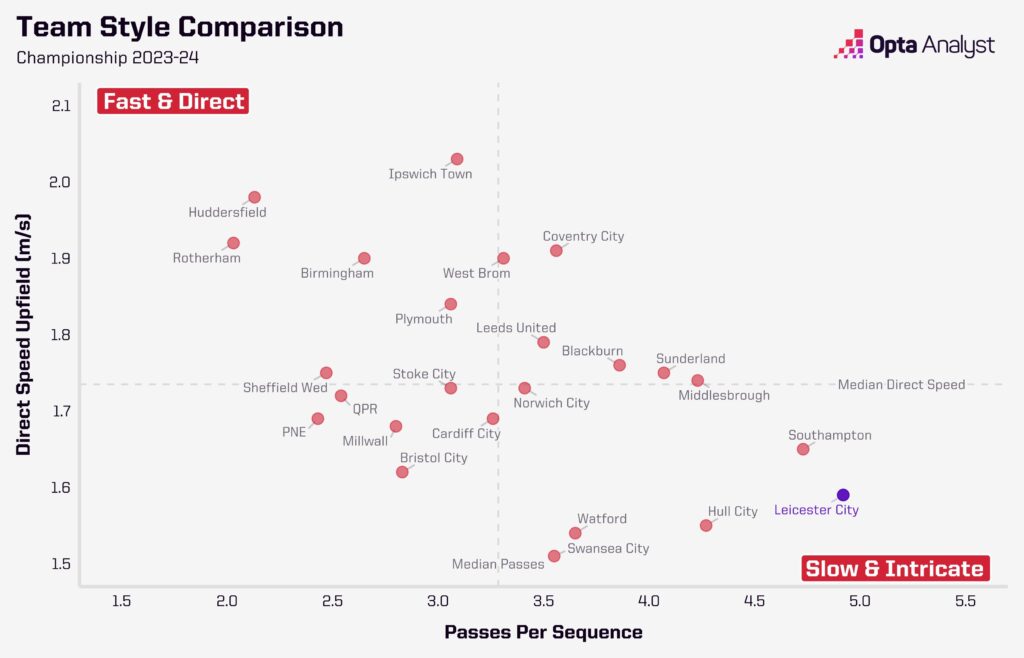
A deeper look at their possession numbers shows more dominance. Their average open-play sequence time is a league-high 13.9 seconds, while they average a league high 4.9 passes in those open-play sequences. They’ve tallied the most open-play passing sequences of at least 10 passes (222), with 55 of those ending in either a touch in the opposition box or a shot. In basic terms, they are the most intricate side in possession of the ball in the Championship this season – similar to Burnley in their title-winning campaign under Vincent Kompany last term, but a shade above their 4.2 passes and 12.1 seconds per open-play sequence.
Leicester have attempted four shots in the Championship this season with a passing sequence of at least 25 passes in the build-up to the attempt – that’s the same tally as all the other 23 Championship sides in 2023-24 combined. One of those – Wilfred Ndidi’s 45th-minute strike at Southampton on 15 September – found the back of the net following a move of 33 passes. No other Championship goal this season has been scored from a sequence of more than 16 passes.
This isn’t to say that they don’t counter-attack, though. With 11 shots from fast breaks in the Championship this season, they are one of the leading sides at shots in transition behind only Plymouth (16), Blackburn (15) and Leeds (12).
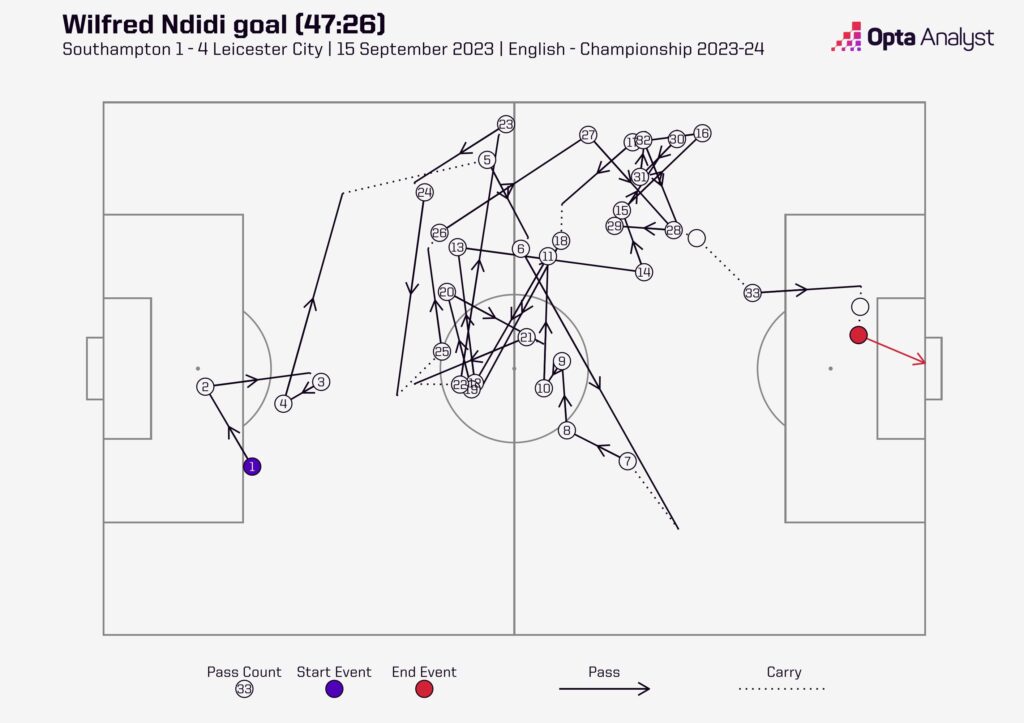
Even without the ball, Maresca’s side work hard to win it back before the opposition get out of their own half. Their PPDA (opposition passes per defensive action) is the fourth lowest in the competition at 11.3, while no side have scored more goals following high turnovers than they have (four) already in 2023-24.
One minor criticism of Leicester has been that they don’t have their possession in the most dangerous of areas on the pitch. Only Hull (23%) have seen a lower proportion of their successful passes end in the final third of the pitch than Leicester (25%) this season, but a lot of that can be explained by Leicester not needing to get the ball into attacking areas as much, having led in games as often as they have.
Field tilt is a measure of territorial dominance between teams. It looks at the share of possession each team has in their attacking third compared to their opponent, and Leicester’s is only the fifth highest in the Championship at 59.6% and well below that of Burnley last season (66.9%). That being said, Burnley often had to apply pressure in the attacking half due to game state – goals scored in the final 30 minutes of Championship matches last season won Burnley 20 points more (31) than their opponents (11).
Who Are Leicester’s Key Players?
Unsurprisingly for a team who see a lot of their passes made in the defensive half, Leicester’s defenders see lots of the ball.
Of players to play at least 300 minutes of Championship action for Leicester this season, four of their five most frequent passers on a per-90-minute basis are their most used back four in recent games (Jannik Vestergaard, Wout Faes, James Justin and Ricardo Pereira), with the other being the deep-lying central midfielder Harry Winks. In fact, of all Championship players to play at least 300 minutes this season, Vestergaard’s 94 successful passes per 90 is the highest in the league, while Winks’ 84 average is the highest by any midfield player. Even when Vestergaard is missing, it’s integral for the central defenders to be comfortable on the ball. Conor Coady came into the side for the recent 3-0 home win over Preston North End and completed more passes than anyone else on the pitch (120).
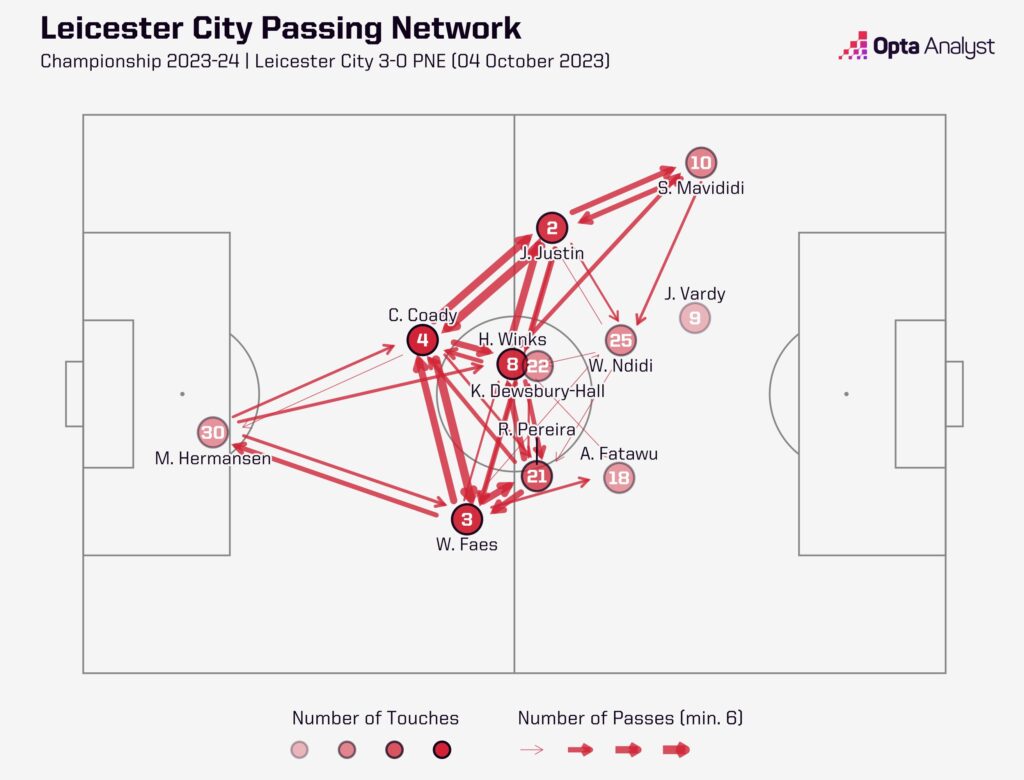
While Justin has spent time out injured and Leicester have been forced to use other players in that left-back role (Hamza Choudhury played there in their last game, a 2-0 win over Stoke on 7 October), Maresca has used Pereira at right-back for the majority of the league season (875 mins of 990). His role in the system is as an inverted full-back in possession, often coming inside to support Winks in building up play through the middle of the pitch and allowing one of the most talented players in the Championship – Kiernan Dewsbury-Hall – more freedom to attack.
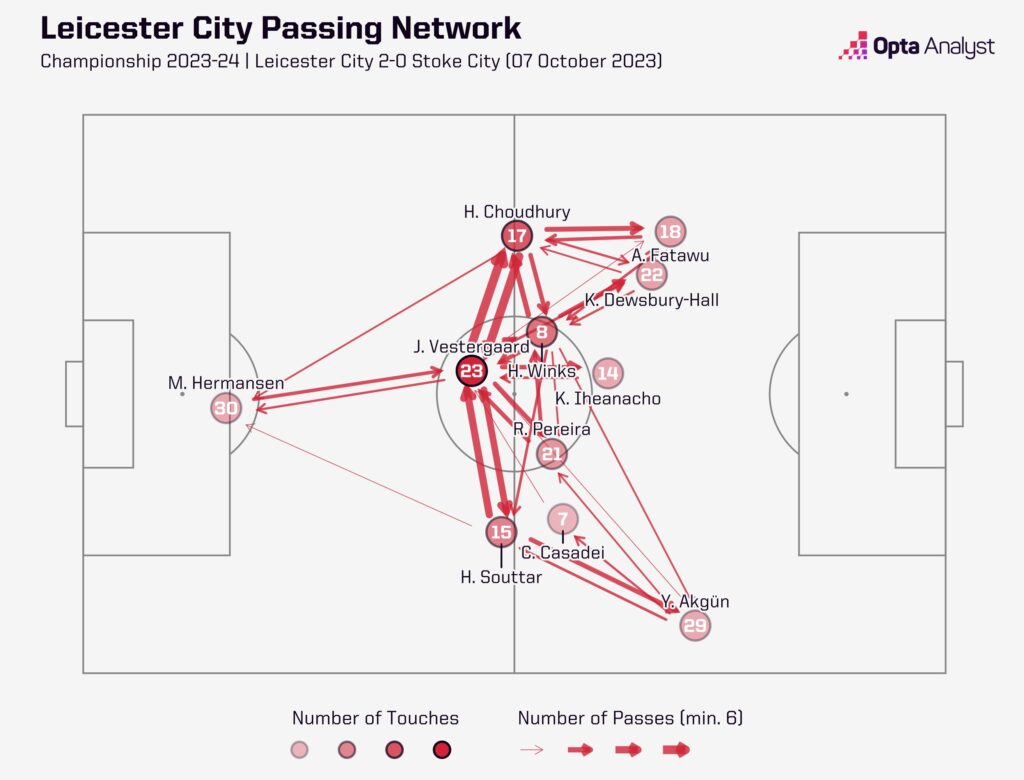
With Pereira’s constant movement inside when Leicester are in possession, this has contributed towards the most lopsided attack in the Championship. No team has seen a smaller proportion of their touches in the attacking half on the right side of the pitch than Leicester (28.6%), while their proportion through the middle is the biggest (32.0%).
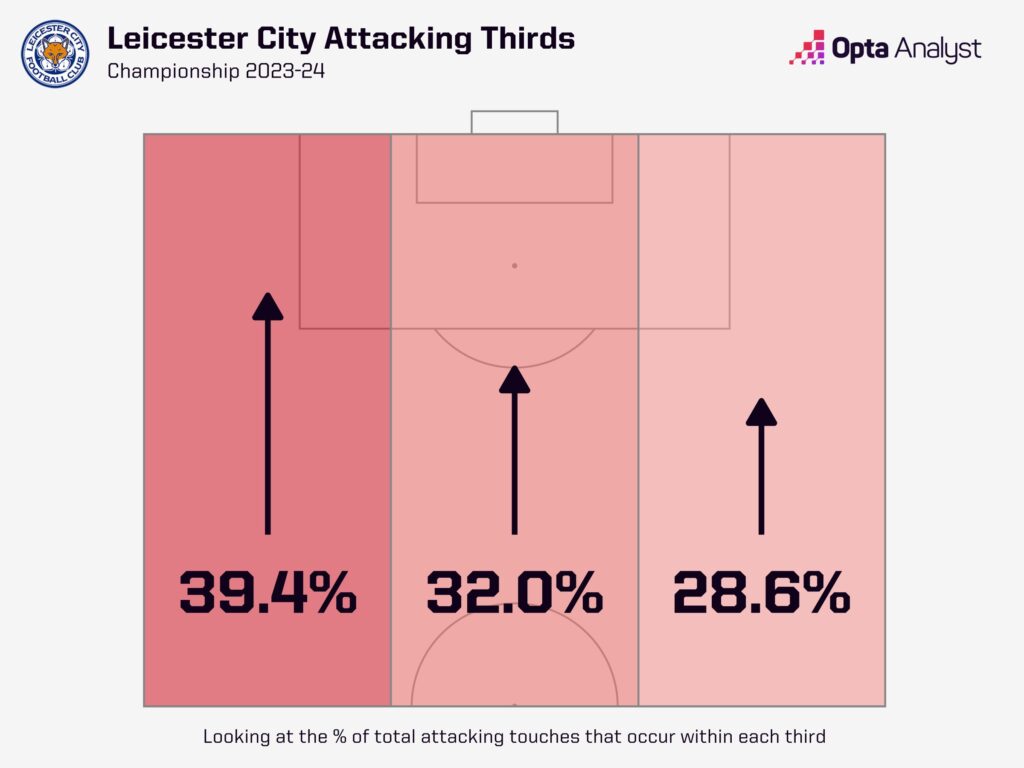
Much of that is down to the talent they have in the middle. Both Winks and Dewsbury-Hall are arguably playing a level below where they should be, so it comes as no shock to have seen Maresca use them the most frequently of all Leicester players in the Championship this season. Winks has missed just seven minutes of league action, while Dewsbury-Hall has played 924 of a possible 990 minutes on the pitch.
Dewsbury-Hall leads the Championship for the most open-play shot involvements (86) while only Plymouth’s Finn Azaz (9.3) has been involved in more on a per-90 average (8.4) of players with 500+ minutes played. Azaz (26) is also the only player in the league to have created more chances for teammates from open play than the 25-year-old Leicester midfielder (25).
Winks is constantly on the ball, with the former England international receiving 842 open-play passes from teammates this season – 123 more than any other Championship midfielder. His involvement in open-play shots is more understated, with his role being earlier in passing sequences. He’s been involved in 63 of Leicester’s open-play shots but a league-high 52 of those have seen his only involvement being in the build-up, rather than as the creator or player to attempt the shot. He’s also made the second-highest number of secondary chances created (the pass before a chance created) with 18, two behind Hayden Hackney of Middlesbrough (20).
Both players are key to winning the ball back for Leicester, too. Dewsbury-Hall has won possession from opponents in the final third of the pitch on 16 occasions this season, which is four higher than any other Championship player, while Winks has started five of Leicester’s open-play passing sequences that have ended in a shot by winning possession back from an opponent – only Norwich’s Shane Duffy (six) and Ipswich’s Massimo Luongo (seven) have done so more often.
Healing Scars
Jamie Vardy may still be scoring goals, pestering defences and annoying opposition supporters at the age of 36, while he’s joined in the 30+ club by teammates Marc Albrighton and defenders Vestergaard, Coady and Pereira, but the core of Leicester’s side are in their peak ages or below.
They’ve used the loan market wisely, bringing in Abdul Fatawu (19 years old), Callum Doyle (20) and Cesare Casadei (20), all under 21 years old, while four-goal Kasey McAteer (21) is another player who has played in over half of their Championship games this season. Leicester’s average starting XI age of 25 years and 364 days is only the 10th youngest in the Championship this season, but that average is dragged up by Vardy, who has played in all 11 games.
The club are clearly at the start of a rebuild, with many players departing in the summer following relegation. Some, like the excellent James Maddison and Harvey Barnes, were always going to happen following the drop to the Championship. Others, such as Youri Tielemans, Daniel Amartey, Ayoze Pérez and Çağlar Söyüncü, were released and allowed the club to offload high earners and free up spots in the squad for those young loanees.
Those that did stay, such as Vardy, Ndidi, Pereira and Kelechi Iheanacho have all contributed towards their great start, while homegrown talent Choudhury returned following a decent loan spell at Watford last season.
The last time Leicester came up from the Championship, they won the Premier League title within two years. While that dream looks an even bigger stretch this time around, Leicester and Maresca are showing there are reasons for the fans to be excited about the rest of this season and beyond, on the pitch.
Enjoy this article? Let us know on our social accounts over on X, Instagram, TikTok and Facebook. You can also subscribe to our new football newsletter to receive exclusive weekly content.
